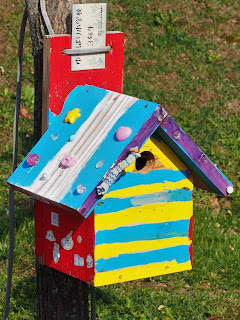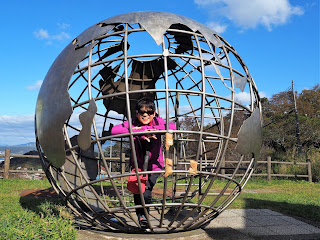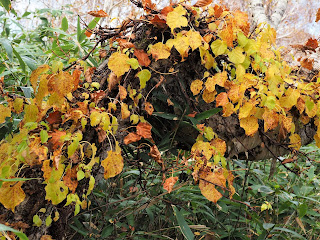Falling for the fall colours in Hokkaido, Japan in 2018
Part 2
Japanese red-crowned crane park at Kushiro
The red-crowned cranes in Hokkaido are non-migratory birds, up to 1.6 m in height and weighing up to 11 kg. They have a patch of red bare skin on the crown. They are a protected species. Cranes are well liked in Japan as they are a symbol of longevity.
Ban’ei horse racing in Obihiro
This is a unique form of horse racing, one of a kind in the World. The horses here compete for speed and power, pulling a sled with weights up to 1 ton, over a sandy course of 200 m, including over 2 slopes. The jockey stands on the sled to control the horse. The race started in the early 1900s and at one time there were 4 cities in Japan having this kind of races. But interest has declined due to the invention of electronic games. The race in Obihiro is the only one surviving, supported by generous sponsorship from a few big Japanese corporations to maintain the heritage.
12 - Akan
Akan, population 6,500, is the home town of the original natives of Hokkaido, the Ainu people. The Japanese (the Yamato) from the south started coming to Hokkaido in the 13th century. Gradually Hokkaido was colonised by the Yamato people. The Ainu population fell greatly due to elimination, assimilation and disease like small pox. The current Ainu population is estimated between 25,000 and 200,000. Shown some decorated buildings, accompanied by Jenny. Also a beautiful cast-iron manhole cover.
Owls
The Ainu people believe all thing have spirits, including plants. Among animals the bears, killer whales and owls have the highest ranked spirits and become gods. The owls are worshipped as the protector of homes and villages. Shown a few of the many interesting wooden owl carvings here. The last photo shows a bunch of totem poles.
Exhibition by Masamitsu Takiguchi
Masamitsu Takiguchi is a renowned deaf Ainu sculptor. Happened to see his exhibition held at a local 5-star hotel in Akan.
13 – Noboribetsu Onsen
From Obihiro we moved south-west to Noboribetsu Onsen, famous as a hot spring resort. At a certain highway stop of the journey there were over 10 cute letter boxes fixed to poles or trees, made by some primary school students. Shown 2 of them.
Town scene
Noboribetsu is a city with 50,000 people and within the city is this town of Noboribetsu Onsen, famous as a hot spring resort. The main attraction is a place called "Hell Valley" with hot steam vents, sulphurous streams, etc. To promote tourism the town itself is “decorated” like a “hell” with many statues of demons, each holding a stick with spikes. The one at the entrance to the town, 1st photo, is some 15 to 20 m tall. The last one, the Hell Emperor, is housed in a shop lot, with several rounds of light shows in the evening. The show includes strong lights coming out from the eyes, thundering sound from everywhere, his head turning, arms moving, etc.
Hell Valley
This is an area where the rocks are red in colour and sulphurous gases explode from the ground and bubble up in the form of gassy vents.
There is a pond at the centre of the area with bubbling activity. A river flows out of this pond into the woods. At a certain section of the river the water is warm enough as a natural foot spa. People gather along the short stretch to have foot spa, including our members CL and AF.
14 - Mt Usu and Lake Toya
From Noboribetsu Onsen we went north-west to the Mt Usu region. First had a photo stop at Cape Chikyu, fronting the Pacific Ocean and a famous location for watching sun rise. “Chikyu” means “earth” in the Japanese language. Hui and wife are seen pulling the Bell of Happiness.
Mt Usu
Mt Usu and Lake Toya are located in the Shikotsu-Toya National Park. There is this Usuzan Ropeway which takes visitors to a park near the peak. The 2nd photo shows the small park next to the base station of the Usuzan Ropeway. The mountain in the photo is Showa Shinzan, a new mountain which rose up from the flat wheat field after Mount Usu erupted in 1944. It rose to 402 m within 2 years. Simply amazing. The statue is Japanese postmaster Masao Mimatsu (1888-1977) who recorded in details the birth and growth of this mountain over the initial years.
We took the ropeway up to the summit station. Views seen while on the ropeway.
Now at the summit station. Mt Usu is an active volcano last erupted in 1977 and 2000. The 2nd photo shows the location of the crater of the 1977 eruption.

Lake Toya
Lake Toya is a round volcanic caldera lake about 10 km in diameter. The 1st photo of the lake was taken at the summit station of the Usuzan Ropeway while the 2nd at ground level
Volcano Science Museum
Visited this niche museum showcasing Mt Usu's recent eruptions, the effects on the environment, etc.
Lake Hill Farm
Went to a place called Lake Hill Farm which has a cottage-like cafe set in a relaxing surrounding with beds of blooming flowers and a view of Mt Yotei, the famous Mt Fuji lookalike. The signature product is their famous gelato, a kind of less-fatty and less-sweet ice cream.
15 – Niseko
Niseko is a town in south west Hokkaido with a population of 5,000. It is a famous ski resort, offering exceptionally low hotel room rates in autumn. That is why we chose to stay here, a 4-star hotel called “Nest at the Trees”. Shown the cute nostalgic display at the reception area.
Shinsen Marsh Park
The main attraction here is the Shinsennuma or Shinsen Marsh Park. Walked for 2 hours, mostly on timber boardwalk, to appreciate the wetland ecology: ponds, lakes, grassland, shrubs, etc. We had to have our raincoats on as there were intermittent light drizzles. Even the creepers compete for autumn colours, last photo.
Makkari
Later we were at the town of Makkari. There are several places here where the locals collect natural spring water from Mt Yotei. We the kiasu joined in too.
Takahashi Dairy Farm
This is a farm famous for their dairy products like fresh milk, yoghurt and of course ice cream. Real farm and great surrounding with Mt Yotei in the distance. Members enjoying the stop with Keith trying out the tractor.
16 - Otaru
From Niseko we went north to the port city of Otaru, population 115,000. On the way visited the Nikka Brewery for whisky tasting. Free whisky! See how happy the men are!
Otaru Canal
The canal, dug at the beginning of the 20th century, was used by small cargo vessels to transport goods from the big ships to the warehouses located along the canals. The canal became obsolete when modern dock facilities allowed for direct unloading of larger vessels. Most part of the canal has been levelled up except a short stretch which was beautified to become a tourist attraction.
Sakaimachi Street
The touristic Sakaimachi Street runs parallel to the old canal. The original buildings were offices and warehouses of trading and shipping companies, many built in the Western style. They are now mostly converted to cater for the tourist trade, like cafes, souvenir shops, etc. The juicy, crunchy Furano melon cost RM 11 a slice.
A notable store here is the Music Box Museum, which is not a museum but a chain store selling music boxes and other tourist favourites, with 7 locations in Otaru. Shown a big store on this tourist street with a steam clock in front of the building, and the music boxes. And a roadside pumpkin decoration to welcome the American festival of Halloween.
17 - Sapporo
From Otaru we went back to Sapporo, our gateway to Hokkaido. We went to the Sapporo University campus to admire the Japanese ginkyo trees in autumn colours. Found some golden fruits among the yellow leaves. Another tree, not a ginkgo, is on fire and every tourist is shooting.
18 - Completion - Reflection
Our tour to Hokkaido is ended. On reflection one has to admire Japan and the Japanese for the cleanliness, orderliness, civic-mindedness to enjoy the expensiveness of touring Japan.
I tried the Japanese hot spring bath for the first time in my life: the onsen. You soak in a common pool with other fully naked people. Men and women in separate pools of course. I did it at Asahidake Onsen. Fortunately or unfortunately there was only one another man at the pool and he was not from our group. No embarrassment whatsoever. May be the experience is not complete. Shown the bathing/scrubbing area beside the pool, 1st photo.
Most of the toilets we encountered are of the high tech type with an elaborate control panel, many buttons, 2nd photo. However in a certain toilet at the Sapporo University, we just could not locate the most important "button" to press: button to flush. All 3 of us who used the toilet had the same problem.
This tour is marketed by YonGo Travels (www.yongo.biz). Many thanks to our tour leader Rachel, our drivers and every member for making this trip enjoyable. Special mention goes to the "Hot 4" who so often cheered us up in the cold morning with their hot bodies in the 5 degree nearly-freezing environment.
And to the readers, thank you for your virtual company.
(First written and posted as daily WhatsApp messages during the tour in October 2018. Revised to this PDF format in September 2021)

























































































No comments:
Post a Comment